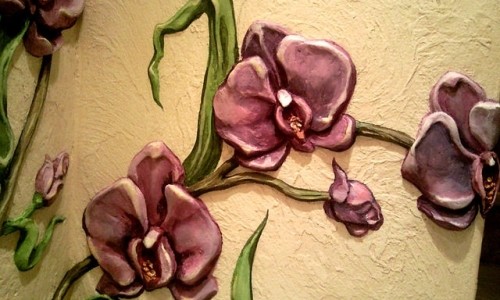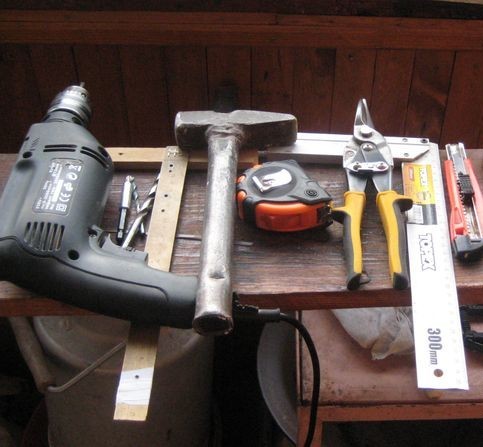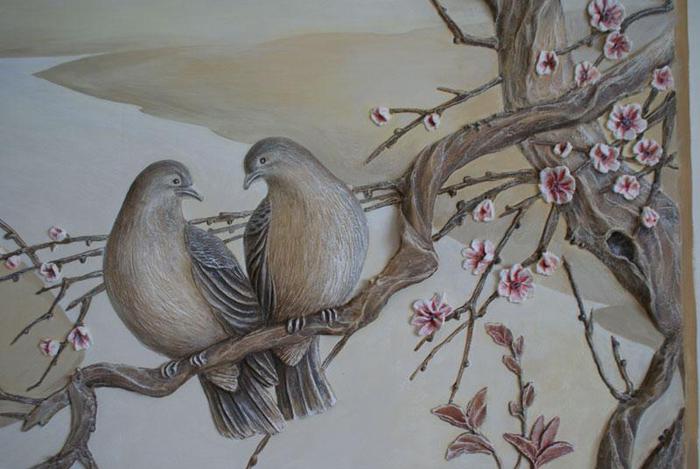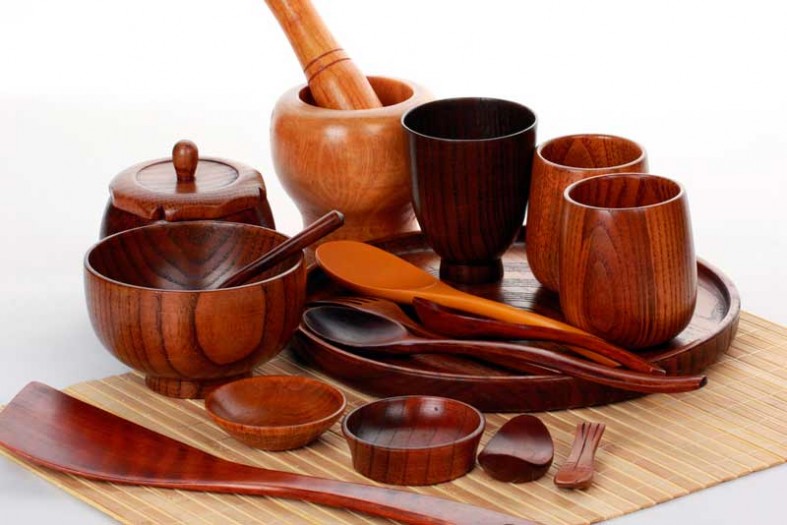Molding on the walls of interior spaces is alwayswas considered a sign of good taste and wealth. Today, despite the fact that there is a wide variety of different plaster and plastic ready-made elements that can be used to decorate the walls of a particular room in the house, but molding on the wall with your own hands will bring a lot of pleasure and make you proud of your work. Of course, because you did it yourself. Someone may think that molding on the wall is difficult. Not at all. Every person who has never molded before can easily cope with such work. There would only be a desire to create. Beautifully designed molding will decorate any wall, making it expensive and stylish.
Beautifully designed molding will decorate any wall, making it expensive and stylish.
How to make a modeling on the wall with your own hands
This will require:
- building mix for plaster;
- sculptural clay (or other material);
- stacks, knife, mixing tanks;
- rolling pin.
Before you start sculpting, you shouldprepare the wall of the room, it should be carefully leveled with plaster. The clay for modeling should be mixed so that it does not stick to your hands. The elements of the intended composition will be formed from it. Part of the clay is mixed in a container until it reaches the consistency of liquid sour cream. It is called slip and is needed to connect the finished elements together. Tools for modeling.You can sculpt anything, but most often, various plant compositions are made. From a piece of mixed clay, you need to break off as much as is needed to create one element, and the rest of the clay should be kept wrapped in a wet cloth and a plastic bag. This will protect it from drying out. You can use a simple example to see how easy it is to sculpt a bunch of grapes. You need to take a grape leaf, put it on a plastic film and trace the contour. This will be a template. Then mix the clay and slip. Roll a piece of clay into a flat cake with a rolling pin and attach it to the wall surface with slip. Place the template on the clay and trace the contour. Remove excess clay using tools. You can use both professional tools (stacks) and any improvised ones. First, form the contour of the leaf, and then the inner part (veins and depressions). The leaf should be on the vine. Therefore, roll a thin tourniquet out of clay and attach it to the wall. Then balls are rolled from clay and a bunch of grapes is formed. After production, the composition should dry. Then, together with the wall, it is covered with a primer and painted with water-based paint or whitewashed. You can also make a colored composition by adding color to the paint and using art brushes. Return to contents</a>Modeling using putty and othermaterials Instead of sculptural clay, you can use putty. It is mixed in a container, applied to the wall, and while the putty is wet, the elements of the composition are formed. It is recommended to form small sections sequentially, since this material dries quite quickly. Instead of putty, you can use gypsum or alabaster.
Tools for modeling.You can sculpt anything, but most often, various plant compositions are made. From a piece of mixed clay, you need to break off as much as is needed to create one element, and the rest of the clay should be kept wrapped in a wet cloth and a plastic bag. This will protect it from drying out. You can use a simple example to see how easy it is to sculpt a bunch of grapes. You need to take a grape leaf, put it on a plastic film and trace the contour. This will be a template. Then mix the clay and slip. Roll a piece of clay into a flat cake with a rolling pin and attach it to the wall surface with slip. Place the template on the clay and trace the contour. Remove excess clay using tools. You can use both professional tools (stacks) and any improvised ones. First, form the contour of the leaf, and then the inner part (veins and depressions). The leaf should be on the vine. Therefore, roll a thin tourniquet out of clay and attach it to the wall. Then balls are rolled from clay and a bunch of grapes is formed. After production, the composition should dry. Then, together with the wall, it is covered with a primer and painted with water-based paint or whitewashed. You can also make a colored composition by adding color to the paint and using art brushes. Return to contents</a>Modeling using putty and othermaterials Instead of sculptural clay, you can use putty. It is mixed in a container, applied to the wall, and while the putty is wet, the elements of the composition are formed. It is recommended to form small sections sequentially, since this material dries quite quickly. Instead of putty, you can use gypsum or alabaster. Photo 1.The plastered relief painted walls will decorate the children's room. The described method can be used to decorate the wall with relief. But you can make a three-dimensional image and decorate, for example, the wall or corner of the children's room. The child will be simply delighted with such decoration (photo 1). The easiest way is to make all the same plant compositions, as in the given example with grapes. Let's consider how you can sculpt a three-dimensional tree branch with leaves and a bird sitting on it. In order for the branch to be three-dimensional, you need to make a frame. It is made of wire, which is screwed to the wall of the room using self-tapping screws. In the wall at the attachment points, you must first drill holes and hammer plastic dowels into them. The wire fixed to the wall should be wrapped with a bandage and coated with a solution of sculptural clay, putty, plaster or alabaster. Using a knife, you need to form the bark of the tree on the resulting branch. All that remains is to attach the leaves and sit the bird on the branch. The bird is easiest to mold from clay, as it is more flexible. After drying, the entire composition is painted. You can use gouache or water-based paint, adding color to it. Such decoration looks simply magnificent, especially if you make a backlight using a small spotlight with a directed beam of light. Return to the table of contents</a>Decorating the living room with a stucco composition Wall inThe living room can also be decorated with a large plant composition molded from putty. You need to choose an open surface that is not covered by interior elements and furniture. As already mentioned, the wall should be completely smooth. It is easier to work with plant elements, since symmetry is not required. A composition with large details, such as a large flower or tree, is more suitable for the living room.
Photo 1.The plastered relief painted walls will decorate the children's room. The described method can be used to decorate the wall with relief. But you can make a three-dimensional image and decorate, for example, the wall or corner of the children's room. The child will be simply delighted with such decoration (photo 1). The easiest way is to make all the same plant compositions, as in the given example with grapes. Let's consider how you can sculpt a three-dimensional tree branch with leaves and a bird sitting on it. In order for the branch to be three-dimensional, you need to make a frame. It is made of wire, which is screwed to the wall of the room using self-tapping screws. In the wall at the attachment points, you must first drill holes and hammer plastic dowels into them. The wire fixed to the wall should be wrapped with a bandage and coated with a solution of sculptural clay, putty, plaster or alabaster. Using a knife, you need to form the bark of the tree on the resulting branch. All that remains is to attach the leaves and sit the bird on the branch. The bird is easiest to mold from clay, as it is more flexible. After drying, the entire composition is painted. You can use gouache or water-based paint, adding color to it. Such decoration looks simply magnificent, especially if you make a backlight using a small spotlight with a directed beam of light. Return to the table of contents</a>Decorating the living room with a stucco composition Wall inThe living room can also be decorated with a large plant composition molded from putty. You need to choose an open surface that is not covered by interior elements and furniture. As already mentioned, the wall should be completely smooth. It is easier to work with plant elements, since symmetry is not required. A composition with large details, such as a large flower or tree, is more suitable for the living room. Photo 2.You can decorate the living room with a stucco composition using putty. First, draw an outline on the wall surface. Then you can dilute the putty and apply it to the wall with a spatula, immediately forming the desired part of the detail with a knife and other improvised tools. If the putty dries, you can finish the job by carefully cutting off the excess. But it is still easier to work with raw material. You can work with putty in another way, applying it in layers, forming volume. Each layer must dry. The lower layers do not need to be smoothed out, so those that are applied on top will adhere better to them. Some craftsmen recommend mixing the putty, adding toilet paper to it to give the solution better plasticity. Such a flower or tree on the wall of the hall will not only decorate the room, but will also serve as a source of pride for you, since you did all this with your own hands. So, decorating walls with molding is not difficult and does not require professional skills, especially if you use the useful recommendations provided. You also need to use your imagination to create a truly original composition (photo 2). It should be taken into account that the molding composition looks many times more attractive if it is illuminated. Therefore, when choosing a wall for work, you must immediately determine where you can install lamps.</ ul>
Photo 2.You can decorate the living room with a stucco composition using putty. First, draw an outline on the wall surface. Then you can dilute the putty and apply it to the wall with a spatula, immediately forming the desired part of the detail with a knife and other improvised tools. If the putty dries, you can finish the job by carefully cutting off the excess. But it is still easier to work with raw material. You can work with putty in another way, applying it in layers, forming volume. Each layer must dry. The lower layers do not need to be smoothed out, so those that are applied on top will adhere better to them. Some craftsmen recommend mixing the putty, adding toilet paper to it to give the solution better plasticity. Such a flower or tree on the wall of the hall will not only decorate the room, but will also serve as a source of pride for you, since you did all this with your own hands. So, decorating walls with molding is not difficult and does not require professional skills, especially if you use the useful recommendations provided. You also need to use your imagination to create a truly original composition (photo 2). It should be taken into account that the molding composition looks many times more attractive if it is illuminated. Therefore, when choosing a wall for work, you must immediately determine where you can install lamps.</ ul>


